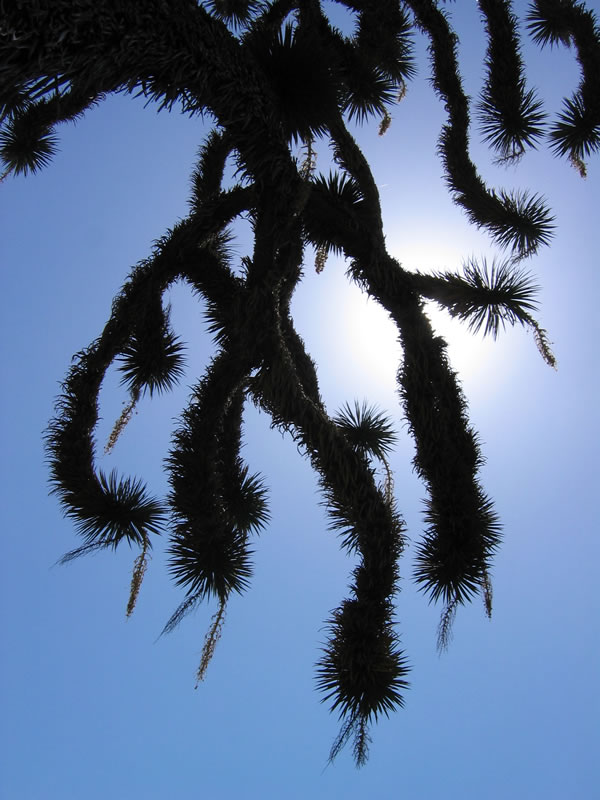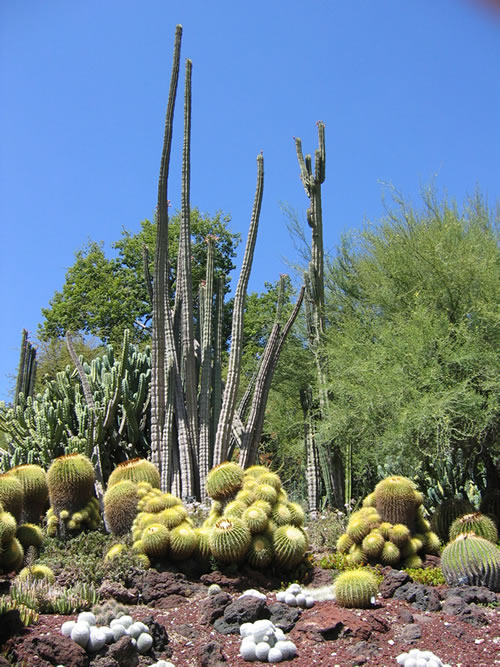The Huntington: Botany, Art, and Movie Magic
By Jamie Hancock
 |
| One of the prickly desert plants reaching out its tentacles. |
Unless you want to nestle next to a pipe organ cactus, there is very little shade in the desert. Battered constantly by rays, your body sweats and your muscles tire with each step. When sunscreen runs into your eyes, you have to make an important decision: Do you use your supply of drinking water to wash out the Coppertone? Or do you press on toward the next oasis?
I opted to save my precious last drops of Aquafina. I wandered a few hundred yards up a barren trail, and finally stumbled into the men’s bathroom of the air-conditioned exhibition hall. Strolling past Shakespeare folios and a Gutenberg Bible (one of twelve existing vellum copies), I made my way to the men’s sink to stop my painful squinting. Once again able to see, I returned to the exhibition area to examine a picture of a white barn owl clutching a squirrel in its talons, high above a lush green valley. I was staring at a page from a “double elephant” folio reprint of John James Audobon’s “Birds of America” (unfinished due to the Civil War). Another barn owl is perched on a lower branch, with its beak lunging for the prize kill. There is still a burning sensation in my right eye...and I remember that I had narrowly escaped sunstroke. But now I am interested in what is contained within the glass cases of this hall.
Disorientation is a common reaction for visitors at The Huntington in San Marino, California. At one moment, you are observing the graceful movements of a turtle in a pond of white lilies. Minutes later, you are examining the elegant pose of a wealthy heiress in a John Singer Sargent portrait. There is just so much to see, and it’s difficult to stay focused - over 120 acres of botanical gardens, a conservatory, a library exhibition hall, and three art gallery buildings (not counting the Huntington mansion under renovation). And a tearoom. Oh yeah, and a mausoleum.
 |
| Cacti clump together to find partial shelter from the heat. |
My journey had begun in the Desert Garden. With the help of a trained guide, I avoided “creeping devils” and other forms of cacti. While wild parrots chattered loudly, I was introduced to the aloe trees that inspired Dr. Seuss’ outlandish plant drawings (different from the medicinal aloe plants). Farther down the path, there was a jojoba, also known as the “save the whale” plant. Its seeds produce oil that can replace ambergris, a substance found in sperm whales that acts as a fixative in perfumes. The guide never really got around to telling me how to make tequila from agave. Then again, the telenovela “Destilando Amor” hasn’t taught me much, either...besides how to look suave and angry at the same time.
Maybe it’s not so amazing that the Huntington has imported plants from Mexico, which makes sense given its proximity. But once I ventured into the other themed gardens – Australian, Jungle, Subtropical, etc. – I realized that Henry Huntington and his descendants were obsessed with collecting anything in the world that might grow in a Southern Californian climate. Not far from the lily ponds is an ombu tree, with its massive, fire-resistant trunk. Commonly found in Argentina, the ombu is referred to as a “lighthouse” of the pampas because it is used as a signpost, a rendezvous point, or just a place for gauchos to seek shade. My tour group did not pause there for long, because we were headed toward what is probably the crowning achievement of the landscape designers and gardening staff: the Japanese Garden.
 |
| Filming location for "Memoirs of a Geisha" (courtesy Wikipedia). |
The Japanese Garden is remarkable for its transplantation of vegetation as well as culture. In addition to the bamboo, wisteria, cedars, camellia, and other shrubs native to Asia, there is a shoin (a traditional house with several rooms measured out by tatami mats), stone lanterns and pagodas, a temple bell, lion-dog (shishi or foo-dog) sculptures...well, now I’m just listing things. What’s more masterful is how the garden is laid out. The Japanese Garden reveals itself bit by bit: starting out on a dark, uphill winding path sheltered by bamboo, leading into a courtyard of meticulously-manicured bonsai plants (10-50 years old), continuing through a doorway of an enclosed rock garden, across a canyon on a wooden bridge, and finally connecting to a contoured lawn with reflecting pools, a half-moon bridge, and various blossoming bushes and trees. It’s designed so beautifully and flawlessly that it was featured in the 2005 motion picture “Memoirs of a Geisha.” Yes, that endearing scene between Ken Wanatabe and Ziyi Zhang was filmed 3 miles east of Pasadena, not in Japan.
My trek ended just a few steps away from the English Garden and Tea Room. After enjoying a chicken caesar wrap in the cafeteria, I visited the art galleries. I felt so overwhelmed with the garden tour that it was hard to fully immerse myself in the immense art collection that includes the paintings of Frederic Church, Edward Hopper, and Mary Cassatt. I managed to giggle at a piece called “Bust of a Young Woman” before deciding that I wasn’t in the right frame of mind to appreciate fine American and European art. My experience proves that the Huntington is worth more than one visit.
So far, I have ignored the library’s collection of over 7 million rare books, manuscripts, and other documents, because most of these items are inaccessible to the public. In order to read and inspect rare works of British and American literature and history, you need to at least reach PhD candidacy. Currently the library serves about 1,800 scholars doing advanced research in humanities. Although it seems pretty restrictive, the low-use policy guarantees increased preservation. For most visitors, the Huntington Library Exhibition Hall provides adequate exposure to the collection. A commoner like myself can see the first quarto edition of “Much Ado About Nothing” (1500), letters from Abraham Lincoln’s bodyguard, and a barn owl or two.
If you’re lucky, you might see a group of people filming a television commercial on one of the huge lawns at the Huntington. In my case, there was a scene being shot for ABC’s new drama “Big Shots.” This show probably won’t be on the air for more than four weeks, but the location is priceless.
Sorry, Dermot Mulroney. I really liked you in “The Practice.”
September 24,
2007
Vol. XII Issue 1
Upcoming Events
| 9/24 | iSchool Orientation Week |
| 10/4 | SALA Banned Books Event |
| 10/13 | InfoCamp Seattle |
Find more at the Silverfish Calendar

Top 5
- Sock fetishism
- Sit-down dancing
- Unemployed, writings of
Pinstriping of motor vehicles
- Animal carcasses in art
Find better ones?
Add them to the blog

Will it be...
![]() - AAC-R2
- AAC-R2
- Bookie
- Meta the Fighting Beta Fish
- Bookie
Read
more on the blog

